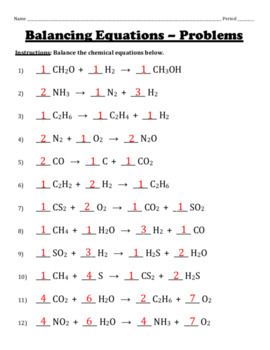
- #Chemical equation balancer science tools manual#
- #Chemical equation balancer science tools software#
#Chemical equation balancer science tools software#
This situation has driven the development of a range of software tools that seek to automate parts of the process to generate reconstruction content, e.g.
#Chemical equation balancer science tools manual#
Manual curation reconstructions involves extensive literature review and sometimes sufficient experimental literature is not in existence. These models are then used in a wide range of biological, biotechnological and biomedical research scenarios. Such reconstructions form the basis for the development of condition-specific metabolic models whose functions are simulated and validated by comparison with experimental results. Other metabolic databases such as EC-BLAST MetaCyc and MetRxn include predicted atom mappings.Ī genome-scale metabolic reconstruction is a structured knowledge-base that abstracts pertinent information on the biochemical transformations taking place within an organism. To our knowledge, only the BioPath and KEGG RPAIR databases disseminate manually curated atom mappings. In addition to prediction accuracy, we found that software accessibility and advanced features were fundamental to the selection of an atom mapping algorithm in practice.ĭue to the time consuming nature of manual curation of atom mapping, it is of great importance to have reliable algorithms to predict atom mappings, especially for large sets of reactions found in metabolic databases and genome-scale metabolic network reconstructions. In addition to prediction accuracy, the algorithms were evaluated on their accessibility, their advanced features, such as the ability to identify equivalent atoms, and their ability to map hydrogen atoms. On average, the accuracy of the prediction was highest for reactions catalysed by oxidoreductases and lowest for reactions catalysed by ligases. Five of the evaluated algorithms had similarly high prediction accuracy of over 91% when compared to manually curated atom mapped reactions. We also compared these predictions to those obtained by manual curation of atom mappings for over five hundred reactions distributed among all top level Enzyme Commission number classes.

How do their predictions compare to each other and to manually curated atom mappings? For more than four thousand metabolic reactions in the latest human metabolic reconstruction, Recon 3D, we compared the atom mappings predicted by six atom mapping algorithms. However, many algorithms exist to predict atom mappings. Complete manual acquisition of atom mapping data for a genome-scale metabolic network is a laborious process. However, a more detailed representation at the underlying level of atom mappings opens the possibility for a broader range of biological, biomedical and biotechnological applications than with stoichiometry alone. Genome-scale metabolic network reconstructions typically represent biochemistry at the level of reaction stoichiometry. This handbook will be of utmost importance as you attempt to solve your first case with your field partner.The mechanism of each chemical reaction in a metabolic network can be represented as a set of atom mappings, each of which relates an atom in a substrate metabolite to an atom of the same element in a product metabolite. By the time you are ready to graduate from the Forensics Academy, you will have a complete Rookie Handbook of information. Next, your coursework will include chemistry lessons that will give you the tools to analyze collected evidence such as lipstick and blood. You will then be ready to complete the first project with a focus on the collection and analysis of crime scene evidence.

Your preparation starts with an introduction to the nervous system and sensory processes. Through this unit, you will move through levels of training and earn badges as you prove your skills. "Have you ever watched a crime show and said to yourself, 'I should be an investigator I could totally solve that!'? Now is your chance to show off your crime-solving skills.Ĭongratulations! Your class has been accepted into the Forensic Academy! In this unit, students will be sent through a fictitious Forensics Academy to learn chemistry principles and evidence-gathering skills they need to solve a non-violent crime. This is an NGSS unit that integrates a storyline and projects with existing Kesler Science inquiry labs, station labs, and 5E Lessons.


 0 kommentar(er)
0 kommentar(er)
